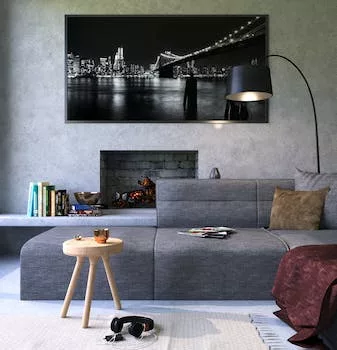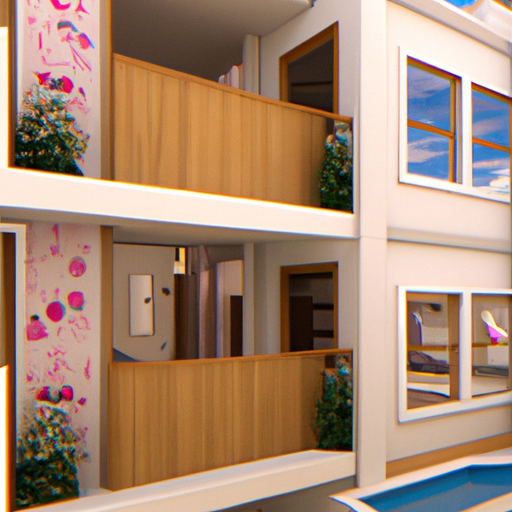Balancing Functionality and Aesthetics in Family-Friendly Complex Designs
Creating a modern complex that is perfect for family living requires a delicate balance between functionality and aesthetics. A well-designed family-friendly complex should not only be visually appealing but also cater to the diverse needs of its residents. This article will discuss some essential design considerations that can help architects and developers achieve this balance, ultimately creating a comfortable and attractive living environment for families.
One of the primary factors to consider when designing a family-friendly complex is the layout and organization of the living spaces. Open floor plans are increasingly popular in modern residential design, as they allow for greater flexibility and adaptability. By creating a seamless flow between the kitchen, dining, and living areas, families can easily interact and spend time together, even when engaged in different activities. This open concept also allows for better natural light penetration and improved ventilation, contributing to a healthier and more pleasant living environment.
In addition to open floor plans, it is essential to consider the specific needs of families with children when designing a modern complex. This includes providing ample storage solutions, such as built-in closets and cabinetry, to help keep the living spaces organized and clutter-free. Additionally, incorporating child-friendly features, such as rounded corners on countertops and furniture, can help create a safer environment for young children.
Another critical aspect of designing a family-friendly complex is the inclusion of communal spaces that cater to various age groups and interests. Playgrounds, swimming pools, and sports facilities can provide opportunities for physical activity and social interaction, promoting a sense of community among residents. Furthermore, incorporating green spaces and landscaped areas within the complex can offer a calming and relaxing atmosphere, encouraging families to spend time outdoors and connect with nature.
In terms of aesthetics, a modern complex should reflect contemporary design trends while remaining timeless and adaptable to future changes. This can be achieved by using a neutral color palette, clean lines, and minimalist design elements. Additionally, incorporating sustainable materials and energy-efficient technologies can contribute to the complex’s overall appeal, as more families are becoming environmentally conscious and seeking eco-friendly living solutions.
When it comes to the exterior design of a family-friendly complex, it is crucial to consider the surrounding environment and neighborhood context. The complex should blend seamlessly with its surroundings, complementing the existing architectural styles and landscape features. This can be achieved by using local materials, incorporating native plants into the landscaping, and designing the complex’s layout to respect the natural topography and views.
Finally, it is essential to consider the long-term maintenance and upkeep of the complex when designing a family-friendly living environment. Durable materials and finishes should be used to ensure that the complex remains attractive and functional for years to come. Additionally, incorporating low-maintenance landscaping and easy-to-clean surfaces can help reduce the burden on residents and property managers, ensuring that the complex remains a desirable place to live.
In conclusion, designing a modern complex that is perfect for family living requires a careful balance between functionality and aesthetics. By considering the specific needs of families with children, incorporating communal spaces and amenities, and using contemporary design trends and sustainable materials, architects and developers can create a comfortable and attractive living environment that caters to the diverse needs of its residents. By keeping these design considerations in mind, a modern complex can successfully provide a high-quality living experience for families, fostering a sense of community and promoting a healthy and active lifestyle.
Integrating Green Spaces and Amenities for Enhanced Family Living

Creating a modern complex that is perfect for family living requires a thoughtful approach to design, with a focus on integrating green spaces and amenities that enhance the quality of life for residents. As urban populations continue to grow, the need for well-designed, sustainable, and family-friendly living spaces becomes increasingly important. In this article, we will explore some key design considerations for creating a modern complex that fosters a sense of community, promotes healthy living, and provides a safe and nurturing environment for families.
One of the most important aspects of designing a modern complex for family living is the integration of green spaces. Green spaces not only provide aesthetic appeal but also offer numerous health and environmental benefits. Research has shown that access to green spaces can improve mental health, reduce stress, and encourage physical activity. Additionally, green spaces can help to mitigate the urban heat island effect, improve air quality, and support local biodiversity.
To effectively integrate green spaces into a modern complex, designers should consider incorporating a variety of landscape elements, such as parks, gardens, and green roofs. These spaces should be easily accessible to all residents and provide opportunities for both active and passive recreation. For example, playgrounds, sports courts, and walking paths can encourage physical activity, while seating areas, water features, and shade structures can provide spaces for relaxation and socialization.
Another key design consideration for a modern family complex is the inclusion of amenities that cater to the diverse needs of residents. These amenities should be thoughtfully designed and strategically located to promote a sense of community and encourage social interaction. Some examples of family-friendly amenities include community centers, fitness facilities, swimming pools, and childcare centers. By providing a range of amenities within the complex, residents can enjoy a more convenient and connected lifestyle, reducing the need for car-dependent trips and fostering a more sustainable way of living.
In addition to green spaces and amenities, designers should also consider the layout and orientation of buildings within the complex. Buildings should be arranged in a way that maximizes natural light and ventilation, while also providing privacy and noise reduction for residents. This can be achieved through the use of staggered building heights, strategic placement of windows, and the incorporation of greenery and landscaping elements to create natural buffers between living spaces.
Safety and security are also crucial design considerations for a modern family complex. Designers should prioritize features such as well-lit pedestrian pathways, secure entry points, and surveillance systems to ensure that residents feel safe and comfortable within their community. Additionally, traffic calming measures, such as speed bumps and pedestrian crossings, can help to create a safer environment for children and families.
Finally, sustainability should be a guiding principle in the design of a modern family complex. This can be achieved through the use of energy-efficient building materials and systems, water-saving fixtures, and waste reduction strategies. Additionally, designers should consider incorporating renewable energy sources, such as solar panels or wind turbines, to further reduce the complex’s environmental impact.
In conclusion, creating a modern complex that is perfect for family living requires a holistic approach to design, with a focus on integrating green spaces, amenities, and sustainable features that enhance the quality of life for residents. By considering the diverse needs of families and prioritizing community, health, and environmental factors, designers can create living spaces that are not only functional and attractive but also contribute to the well-being of both residents and the planet.
Innovative Layouts and Materials for Modern, Multi-Generational Complexes
In today’s fast-paced world, the concept of family living has evolved significantly. Gone are the days when families lived in traditional, single-family homes with a white picket fence. Today, modern families are increasingly opting for multi-generational complexes that cater to the needs of all family members, from young children to grandparents. These complexes offer a perfect blend of privacy, convenience, and community living, making them an ideal choice for families looking to create a comfortable and nurturing environment for their loved ones. In this article, we will discuss some innovative layout and material considerations that can help you design a modern complex that’s perfect for family living.
One of the key aspects of designing a modern, multi-generational complex is to ensure that it offers a flexible and adaptable layout. This means creating spaces that can be easily reconfigured to accommodate the changing needs of the family members. For instance, consider incorporating open floor plans that allow for seamless transitions between living, dining, and kitchen areas. This not only creates a sense of spaciousness but also encourages social interaction among family members. Additionally, incorporating features such as sliding walls or movable partitions can help create private spaces when needed, without compromising on the overall openness of the layout.
Another important consideration is to design the complex in such a way that it caters to the needs of family members across different age groups. For instance, young children require safe and stimulating play areas, while teenagers may need dedicated study spaces and recreational facilities. Similarly, elderly family members may require easily accessible living spaces with features such as ramps, handrails, and wider doorways to accommodate mobility aids. By incorporating these elements into the design, you can create a complex that is truly inclusive and caters to the needs of all family members.
In addition to the layout, the choice of materials plays a crucial role in creating a modern complex that is perfect for family living. Opt for materials that are not only durable and low-maintenance but also eco-friendly and energy-efficient. For instance, consider using sustainable materials such as bamboo, reclaimed wood, or recycled metal for construction. These materials not only reduce the environmental impact of the complex but also contribute to a healthier living environment for the family members.
Furthermore, incorporating energy-efficient features such as solar panels, green roofs, and rainwater harvesting systems can help reduce the complex’s carbon footprint and lower utility bills. These features not only make the complex more sustainable but also contribute to the overall well-being of the family members by promoting a greener and healthier lifestyle.
Another aspect to consider when selecting materials is the aesthetic appeal of the complex. Choose materials and finishes that create a harmonious and visually appealing environment. For instance, opt for neutral colors and natural textures that can be easily complemented with pops of color through furnishings and accessories. This not only creates a timeless and elegant look but also allows for easy customization of the living spaces as per the individual preferences of the family members.
In conclusion, designing a modern complex that is perfect for family living requires careful consideration of various factors, including the layout, materials, and the needs of the family members across different age groups. By incorporating innovative design elements and sustainable materials, you can create a multi-generational complex that offers a comfortable, nurturing, and inclusive living environment for all family members. With thoughtful planning and attention to detail, you can create a modern complex that truly embodies the essence of family living in today’s world.
Q&A
Question 1: What are the key design considerations for creating a modern complex that’s perfect for family living?
Answer 1: The key design considerations for creating a modern complex perfect for family living include providing ample living space, ensuring safety and security, incorporating green spaces and recreational areas, prioritizing accessibility and connectivity, and designing functional and flexible layouts.
Question 2: How can a modern complex cater to the diverse needs of families?
Answer 2: A modern complex can cater to the diverse needs of families by offering a variety of housing options, such as apartments, townhouses, and single-family homes, providing shared amenities like playgrounds, swimming pools, and fitness centers, and ensuring proximity to essential services like schools, healthcare facilities, and shopping centers.
Question 3: What role does sustainability play in designing a modern complex for family living?
Answer 3: Sustainability plays a crucial role in designing a modern complex for family living by incorporating energy-efficient building materials and technologies, promoting water conservation through smart landscaping and rainwater harvesting, and encouraging eco-friendly practices like waste management and recycling, ultimately creating a healthier and more environmentally responsible living environment for families.
Conclusion
In conclusion, to create a modern complex perfect for family living, it is essential to consider various design aspects such as functionality, safety, sustainability, and aesthetics. Incorporating open spaces, recreational facilities, and community areas fosters social interaction and promotes a healthy lifestyle. Additionally, prioritizing eco-friendly materials and energy-efficient systems contributes to a sustainable living environment. By carefully balancing these design considerations, developers can create a modern complex that meets the diverse needs of families and enhances their overall quality of life.


